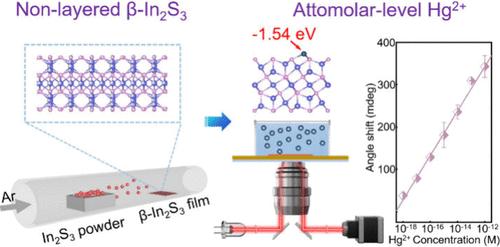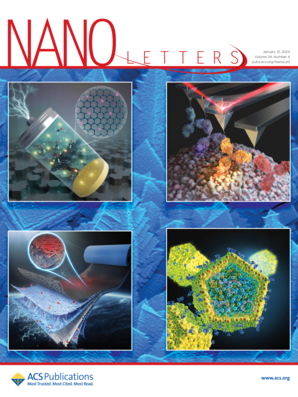High-Active Surface of Centimeter-Scale β-In2S3 for Attomolar-Level Hg2+ Sensing
IF 9.6
1区 材料科学
Q1 CHEMISTRY, MULTIDISCIPLINARY
引用次数: 0
Abstract
Recognition layer materials play a crucial role in the functionality of chemical sensors. Although advancements in two-dimensional (2D) materials have promoted sensor development, the controlled fabrication of large-scale recognition layers with highly active sites remains crucial for enhancing sensor sensitivity, especially for trace detection applications. Herein, we propose a strategy for the controlled preparation of centimeter-scale non-layered ultrathin β-In2S3 materials with tailored high-active sites to design ultrasensitive Hg2+ sensors. Our results reveal that the highly active sites of non-layered β-In2S3 materials are pivotal for achieving superior sensing performance. Selective detection of Hg2+ at the 1 aM level is achieved via selective Hg–S bonding. Additionally, we evaluate that this sensor exhibits excellent performance in detecting Hg2+ in the tap water matrix. This work provides a proof-of-concept for utilizing non-layered 2D films in high-performance sensors and highlights their potential for diverse analyte sensing applications.

用于阿托摩尔级 Hg2+ 传感的厘米级 β-In2S3 高活性表面
识别层材料对化学传感器的功能起着至关重要的作用。虽然二维(2D)材料的进步促进了传感器的发展,但受控制备具有高活性位点的大规模识别层对于提高传感器灵敏度仍然至关重要,尤其是在痕量检测应用中。在此,我们提出了一种策略,用于控制制备具有定制高活性位点的厘米级非层状超薄 β-In2S3 材料,以设计超灵敏 Hg2+ 传感器。我们的研究结果表明,非层状 β-In2S3 材料的高活性位点是实现优异传感性能的关键。通过选择性 Hg-S 键合,实现了 1 aM 水平的 Hg2+ 选择性检测。此外,我们还评估了这种传感器在自来水基质中检测 Hg2+ 的优异性能。这项研究为在高性能传感器中使用非层状二维薄膜提供了概念验证,并凸显了二维薄膜在各种分析物传感应用中的潜力。
本文章由计算机程序翻译,如有差异,请以英文原文为准。
求助全文
约1分钟内获得全文
求助全文
来源期刊

Nano Letters
工程技术-材料科学:综合
CiteScore
16.80
自引率
2.80%
发文量
1182
审稿时长
1.4 months
期刊介绍:
Nano Letters serves as a dynamic platform for promptly disseminating original results in fundamental, applied, and emerging research across all facets of nanoscience and nanotechnology. A pivotal criterion for inclusion within Nano Letters is the convergence of at least two different areas or disciplines, ensuring a rich interdisciplinary scope. The journal is dedicated to fostering exploration in diverse areas, including:
- Experimental and theoretical findings on physical, chemical, and biological phenomena at the nanoscale
- Synthesis, characterization, and processing of organic, inorganic, polymer, and hybrid nanomaterials through physical, chemical, and biological methodologies
- Modeling and simulation of synthetic, assembly, and interaction processes
- Realization of integrated nanostructures and nano-engineered devices exhibiting advanced performance
- Applications of nanoscale materials in living and environmental systems
Nano Letters is committed to advancing and showcasing groundbreaking research that intersects various domains, fostering innovation and collaboration in the ever-evolving field of nanoscience and nanotechnology.
 求助内容:
求助内容: 应助结果提醒方式:
应助结果提醒方式:


